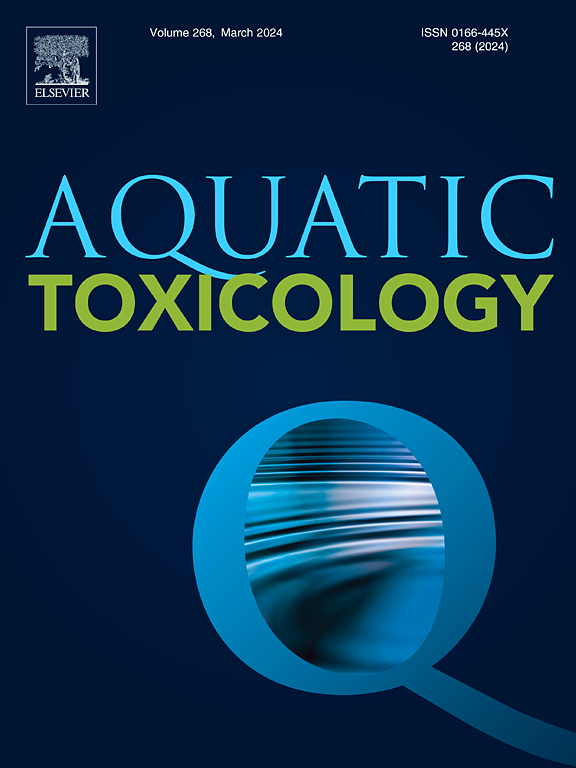Ocean acidification aggravates the toxicity of deltamethrin in Haliotis discus hannai: Insights from immune response, histopathology and physiological responses
IF 4.1
2区 环境科学与生态学
Q1 MARINE & FRESHWATER BIOLOGY
引用次数: 0
Abstract
Ocean acidification (OA) and other environmental factors can collectively affect marine organisms. Deltamethrin (DM), a type II pyrethroid insecticide, has been widely detected in coastal and estuarine areas, while little attention has been given to the combined effects of DM and OA. In this study, Haliotis discus hannai was exposed to three pH levels (8.1, 7.7 and 7.4) and three DM nominal concentrations (0 μg/L, 0.6 μg/L and 6 μg/L) for 14 and 28 days. The results indicated that experimental acidification and/or DM exposure led to impaired immune function and pathological damage. Additionally, acidified conditions and DM exposure induced oxidative stress, and gills are more sensitive than digestive glands. With increasing pCO2 and DM nominal concentrations, superoxide dismutase (SOD) activity decreased, whereas catalase (CAT) and glutathione S-transferase (GST) activities increased in the gills. Moreover, the expression levels of Toll-like receptor (TLR) pathway-related genes were upregulated after exposure. Integrated biomarker response (IBR) analysis proved that acidified conditions and/or DM detrimentally affected the overall fitness of H. discus hannai, and co-exposure to experimental acidification and DM was the most stressful condition. This study emphasizes the necessity of incorporating OA in future pollutant environmental assessments to better elucidate the risks of environmental disturbance.
海洋酸化加剧了溴氰菊酯对汉娜鱼(Haliotis discus hannai)的毒性:免疫反应、组织病理学和生理反应的启示。
海洋酸化(OA)和其他环境因素会共同影响海洋生物。溴氰菊酯(DM)是一种II型拟除虫菊酯杀虫剂,在沿海和河口地区被广泛检测到,但很少有人关注DM和OA的综合影响。在本研究中,将汉娜藻暴露于三种 pH 值(8.1、7.7 和 7.4)和三种 DM 标称浓度(0 μg/L、0.6 μg/L 和 6 μg/L)下 14 天和 28 天。结果表明,实验性酸化和/或 DM 暴露会导致免疫功能受损和病理损伤。此外,酸化条件和DM暴露会诱发氧化应激,鳃比消化腺更敏感。随着pCO2和DM名义浓度的增加,鳃中的超氧化物歧化酶(SOD)活性降低,而过氧化氢酶(CAT)和谷胱甘肽S-转移酶(GST)活性增加。此外,与 Toll 样受体(TLR)通路相关的基因表达水平在接触后上调。综合生物标记反应(IBR)分析表明,酸化条件和/或DM对盘尾鰕虎鱼的整体适应性有不利影响,同时暴露于实验性酸化和DM条件下的盘尾鰕虎鱼应激最大。这项研究强调了将OA纳入未来污染物环境评估的必要性,以更好地阐明环境干扰的风险。
本文章由计算机程序翻译,如有差异,请以英文原文为准。
求助全文
约1分钟内获得全文
求助全文
来源期刊

Aquatic Toxicology
环境科学-毒理学
CiteScore
7.10
自引率
4.40%
发文量
250
审稿时长
56 days
期刊介绍:
Aquatic Toxicology publishes significant contributions that increase the understanding of the impact of harmful substances (including natural and synthetic chemicals) on aquatic organisms and ecosystems.
Aquatic Toxicology considers both laboratory and field studies with a focus on marine/ freshwater environments. We strive to attract high quality original scientific papers, critical reviews and expert opinion papers in the following areas: Effects of harmful substances on molecular, cellular, sub-organismal, organismal, population, community, and ecosystem level; Toxic Mechanisms; Genetic disturbances, transgenerational effects, behavioral and adaptive responses; Impacts of harmful substances on structure, function of and services provided by aquatic ecosystems; Mixture toxicity assessment; Statistical approaches to predict exposure to and hazards of contaminants
The journal also considers manuscripts in other areas, such as the development of innovative concepts, approaches, and methodologies, which promote the wider application of toxicological datasets to the protection of aquatic environments and inform ecological risk assessments and decision making by relevant authorities.
 求助内容:
求助内容: 应助结果提醒方式:
应助结果提醒方式:


